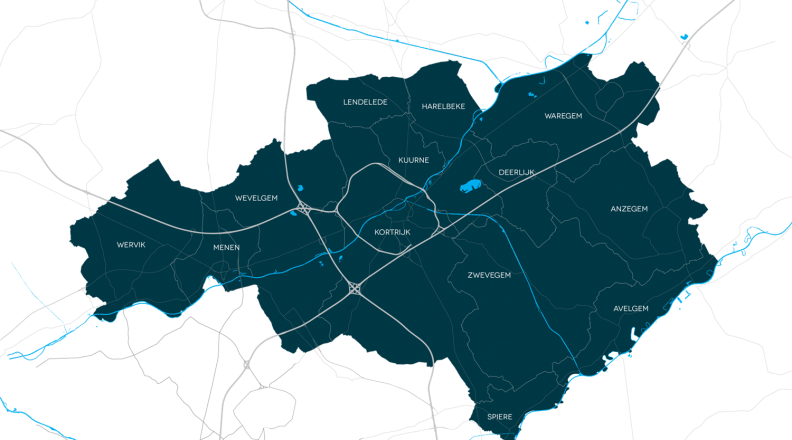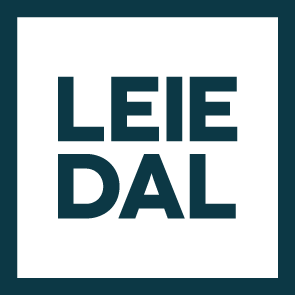The thing about South West Flanders
Our region is located in one of Europe’s most densely populated areas and characterised by an intricate network of small cities and towns. Its socio-economic fabric is flourishing and autonomous. Over the centuries, waterways, railways and roads have each contributed to the region’s urbanisation, resulting in a densely populated, east-west-oriented strip of land with the river Leie, the railroads and motorways as three parallel structures. This cohesion is the basis of our urban development.
South of the urbanised Leie area lies the more rural Scheldt-Leie interfluvial district. North-south-oriented regional roads and the Bossuit-Kortrijk canal connect the Leie and Scheldt valleys, leading to dynamic interactions between these two complementary sub-areas that structure and typify the region.
It is hard to determine this region univocally. It is neither a metropolis nor countryside. The widespread historical pattern of living and working has led to a varied mix of functions. Sometimes, they are closer together, other times more apart. By no means similar to (hyper)concentrated cities such as Brussels or Antwerp, our urbanisation model – often named the ‘horizontal city’ – offers high quality of living, easy access to employment, education and care, and proximity to open space.

Transition sixfold
Our organisation works hard at a sustainable and future-oriented region over the course of six transition lines.
The first, Accessible and Nearby, aims at improving made-to-measure mobility, with a strong focus on mobility points and shared mobility. Shifting goods traffic towards the water is a further commitment, optimising transhipment points and improving the region’s cross-border connections.
The second line, Liveable, Healthy and Inclusive, is all about decarbonising and desurfacing, creating more nature and stimulating meetings and social cohesion in the public environment. An accessible housing market, affordable to everyone, is our aim.
The third transition line, Enterprising and Workable, is meant to create a fertile feeding ground for entrepreneurship, by providing flexible spaces for start-ups and growing businesses. We support projects that reinforce city centres and join the transformation towards a circular economy, in which technological innovation and local growth are central.
On our way to a Carbon-Neutral region, the fourth transition, we implement a regional spatial energy strategy and bring about energy efficiency by way of renovation coaching, among other things. We fully commit to sustainable energy production, distribution and storage.
Our fifth pillar, Space Neutral, centres on a conscious approach to space by realising the Flemish building shift or ‘concrete stop’, limiting the taking up of space and safeguarding open areas. In this light, we also revalue major regional sites.
Digital Transformation, our sixth and final transition line, promotes the development of our LDaaS services (Leiedal Data-as-a-Service). By obtaining, analysing and providing geographical and other data, we contribute to policymaking, monitoring and assessing, helping the region forward.
Following these six transition lines, we are building a resilient, inclusive and innovative region, ready for tomorrow’s challenges.
The project’s aim
Many businesses, particularly small to medium-sized enterprises, still have large steps to take to make their mobility policies durable. Nonetheless, more sustainable commuter traffic offers numerous benefits, both for businesses and employees:
- Healthier employees: frequent exercise, such as cycling to work, has proven positive effects on physical and mental health.
- Increased productivity: active commuters (who cycle or walk) show higher energy and productivity levels at work.
- Less absence through illness: cycling may reduce absenteeism by 1 to 2 days per employee a year.
- Positive environmental impact and fewer traffic build-ups: encouraging less car use reduces carbon emissions and traffic congestion.
A large part of the region’s employees live within cycling distance of their place of work. This sustainability potential, however, remains largely untapped. Businesses find themselves short of time, means and/or knowledge to effectively commit to a sustainable commuting policy.
Mobility coaching offers a solution, guiding businesses in the transition to more sustainable mobility behaviour. In this framework, the Mobility Makers project plays a key role, engaging a mobility coach to guide businesses step by step toward more sustainable mobility solutions.

Stay in touch
Our website: https://www.leiedal.be/
On Facebook: https://www.facebook.com/leiedal
On LinkedIn: https://www.linkedin.com/company/leiedal